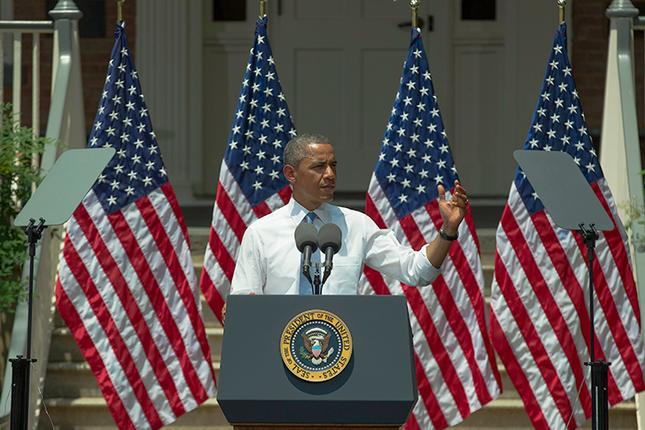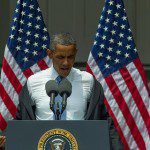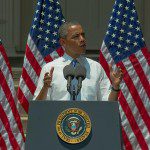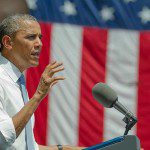Obama Goes Bold on Climate Change Fight in Georgetown Speech
By • April 11, 2016 0 2169

President Barack Obama outlined his administration’s comprehensive action plan to deal with climate change in a landmark speech at Georgetown University June 25.
Obama addressed a small crowd and media from the steps of the Old North Building where George Washington and other presidents as recently as Bill Clinton have spoken.
John DeGioia, president of Georgetown University, even as a U.S. Park Police helicopter flew low over the Dahlgren Quadrangle, heralding the arrival of the president’s motorcade, reminded the crowd of the university’s work on sustainability and interdisciplinary studies on climate and welcomed Obama back to the campus.
Obama thanked supporters, government leaders and “the Hoyas in the house” and launched into a vigorous defense of his view on global warming — outside in the humid heat of a Washington, D.C., summer afternoon. As he had done in his June 19 Berlin speech, Obama advised those in the crowd to remove their jackets and said, “It’s not that sexy.” The president along with the audience sweated in the heat.
At the start of his speech, the president hitched the importance of his climate change plan to the success of the U.S. missions to the moon and what they showed the world.
This ecological vision involves an out-of-this-world event during Christmas 1968 when Apollo 8 orbited the moon and sent back stunning, never-before-seen photos of the Earth from space as astronauts read from the Book of Genesis to a television audience. “And while the sight of our planet from space might seem routine today,” Obama said. “Imagine what it looked like to those of us seeing our home, our planet, for the first time. Imagine what it looked like to children like me. Even the astronauts were amazed. ‘It makes you realize,’ [astronaut Jim] Lovell would say, ‘just what you have back there on Earth.’ ”
From this mythopoetic height, Obama continued along a scientific vein, listing facts and figures to back his case on climate change as the most important challenge of the 21st century.
“The 12 warmest years in recorded history have all come in the last 15 years,” he said. “Last year, temperatures in some areas of the ocean reached record highs, and ice in the Arctic shrank to its smallest size on record — faster than most models had predicted it would. These are facts.”
“Now, we know that no single weather event is caused solely by climate change,” the president said. “Droughts and fires and floods, they go back to ancient times. But we also know that in a world that’s warmer than it used to be, all weather events are affected by a warming planet. The fact that sea levels in New York, in New York Harbor, are now a foot higher than a century ago — that didn’t cause Hurricane Sandy, but it certainly contributed to the destruction that left large parts of our mightiest city dark and underwater.”
He also said he had lost “patience for anyone who denies that this problem is real. . . . In a world that’s warmer than it used to be, all weather events are affected by the warming planet.”
“We don’t have time for a meeting of the Flat-Earth Society,” Obama said. “Those who are feeling the effects of climate change don’t have time to deny it. They’re busy dealing with it.”
“So, the question is not whether we need to act,” Obama said. “The overwhelming judgment of science — of chemistry and physics and millions of measurements — has put all that to rest. Ninety-seven percent of scientists, including, by the way, some who originally disputed the data, have now put that to rest. They’ve acknowledged the planet is warming and human activity is contributing to it.”
Concerning the upcoming decision on the Keystone pipeline, here is what the president said: “Now, I know there’s been, for example, a lot of controversy surrounding the proposal to build a pipeline, the Keystone pipeline, that would carry oil from Canadian tar sands down to refineries in the Gulf. And the State Department is going through the final stages of evaluating the proposal. That’s how it’s always been done. But I do want to be clear: Allowing the Keystone pipeline to be built requires a finding that doing so would be in our nation’s interest. And our national interest will be served only if this project does not significantly exacerbate the problem of carbon pollution. The net effects of the pipeline’s impact on our climate will be absolutely critical to determining whether this project is allowed to go forward. It’s relevant.”
Noting that certain toxins are already captured by power plants, Obama said, “So today, for the sake of our children, and the health and safety of all Americans, I’m directing the Environmental Protection Agency to put an end to the limitless dumping of carbon pollution from our power plants and complete new pollution standards for both new and existing power plants.”
Obama also asked the Senate to confirm his nominee to head the EPA, Gina McCarthy, while he noted that President Richard Nixon created the federal department.
As the president neared the end of his speech, he invited all to get involved. “Americans are not a people who look backwards; we’re a people who look forward,” he said. “We’re not a people who fear what the future holds; we shape it. What we need in this fight are citizens who will stand up, and speak up, and compel us to do what this moment demands.”
- President Barack Obama at Georgetown University June 25. | Tim Riethmiller







